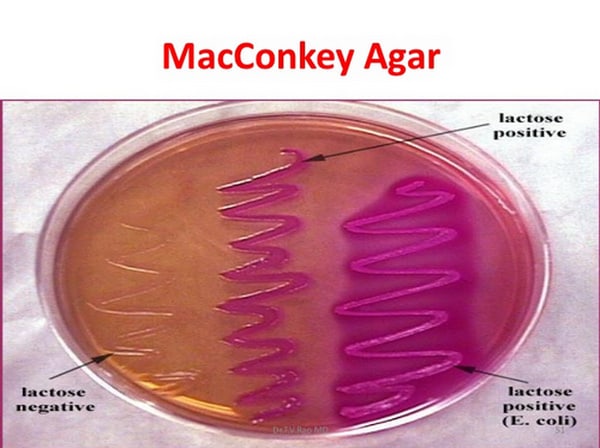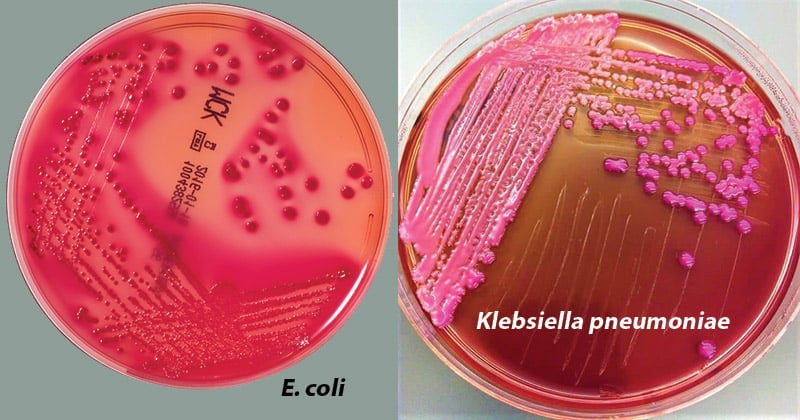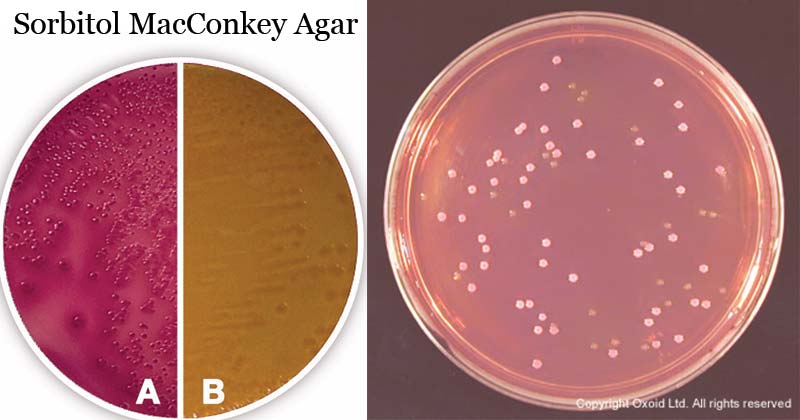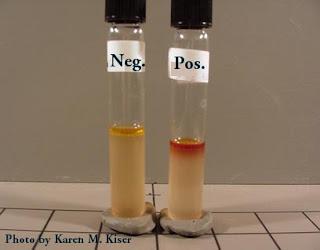|
What is MacConkey Agar?. Components of MacConkey Agar. MacConkey Agar Test Procedure. MacConkey agar Results. Are there any limitations?. What bacteria are selected for when using MacConkey agar?. Why is MacConkey agar selective as well as a differential?. . What is MacConkey Agar?What is its significance? MacConkey Agar is a differential media developed by Alfred Theodore MacConkey in the 20th century.It is both a selective and differential media used to isolate and differentiate non-fastidi Show
 Top 1: MacConkey Agar – Plate, Purpose, Ingredients and PrincipleAutora: laboratoryinfo.com - 102 Avaliação
Descrição: What is MacConkey Agar?. Components of MacConkey Agar. MacConkey Agar Test Procedure. MacConkey agar Results. Are there any limitations?. What bacteria are selected for when using MacConkey agar?. Why is MacConkey agar selective as well as a differential? What is MacConkey Agar?What is its significance? MacConkey Agar is a differential media developed by Alfred Theodore MacConkey in the 20th century.It is both a selective and differential media used to isolate and differentiate non-fastidi
Resultados de pesquisa correspondentes: Mar 07, 2022 · The purpose of MacConkey agar is to isolate Gram-negative enteric bacteria as well as to differentiate between lactose fermenting and non-fermenting lactose gram-negative bacteria. MacConkey agar is also useful in isolating coliforms and intestinal pathogens that are present in the water, dairy products, and other forms of biological specimens. ...
 Top 2: MacConkey Agar- Composition, Principle, Preparation, Results, …Autora: microbenotes.com - 105 Avaliação
Descrição: Principle of MacConkey Agar . Preparation of MacConkey Agar . Result Interpretation on MacConkey Agar. Uses of MacConkey Agar . Limitations of MacConkey Agar MacConkey agar was the first solid differential media to be formulated which was developed in the 20th century by Alfred Theodore MacConkey. MacConkey Agar is the earliest selective and differential medium for the cultivation of coliform organisms. It is used for the isolation and differentiation of non-fastidious. gram-nega
Resultados de pesquisa correspondentes: Jan 06, 2022 · MacConkey agar was the first solid differential media to be formulated which was developed in the 20th century by Alfred Theodore MacConkey. MacConkey Agar is the earliest selective and differential medium for the cultivation of coliform organisms. It is used for the isolation and differentiation of non-fastidious gram-negative rods, particularly members of the … ...
Top 3: BAM Chapter 4: Enumeration of Escherichia coli and the Coliform ...Autora: fda.gov - 180 Avaliação
Descrição: I. Conventional Method for coliforms, fecal coliforms and E.. coli. II. LST-MUG Method for Detecting E. coli in Chilled or Frozen Foods Exclusive of Bivalve Molluscan Shellfish. III. Examination of Bottled Water. IV. Examination of Shellfish and Shellfish Meats. V. Analysis for E. coli in citrus. juices. VI. Other Methods for Enumerating Coliforms and E. coli Bacteriological Analytical Manual (BAM) Main PageAuthors: Peter Feng (ret.), Stephen D. Weagant (ret.), Michael A. Grant (dec.),. Willi
Resultados de pesquisa correspondentes: Oct 09, 2020 · The change was made in part due to the poor ability of the control strain ATCC25922 to grown and ferment lactose to produce acid and gas at 45.5 ± 0.2°C. ... Gram-negative, short rods should be ... ...
 Top 4: Gram Negative Bacteria | LTG - Lab Tests GuideAutora: labtestsguide.com - 98 Avaliação
Descrição: Differences Between Gram Positive and Gram Negative Bacteria Follow @labtestsguideGram-negative bacteria are bacteria that do not retain the crystal violet stain used in the. gram-staining method of bacterial differentiation. They are characterized by their cell envelopes, which are composed of a thin peptidoglycan cell wall sandwiched between an inner cytoplasmic cell membrane and a bacterial outer membrane.They are bacteria that define the opposite of gram-positive bacteria in relation to the
Resultados de pesquisa correspondentes: Feb 20, 2021 · Citrobacter: (Slow Lactose fermenting )a genus of Gram-negative coliform bacteria in the family Enterobacteriaceae. The species C. amalonaticus, C. koseri, and C. freundii can use citrate as a sole carbon source. ... Usually cocci or spore forming rods (exception : Lactobacillus and Corynebacterium) Usually non-spore forming rods (Exception ... ...
Top 5: Types of culture media - SlideShareAutora: slideshare.net - 96 Avaliação
Descrição: We’ve updated our privacy policy so that we are compliant with changing global privacy regulations and to provide you with insight into the limited ways in which we use your data.You can read the details below. By accepting, you agree to the updated privacy policy.Thank you! View updated privacy policyWe've encountered a problem, please try again.
Resultados de pesquisa correspondentes: Examples MacConkey medium • Distinguish between lactose fermenters & non lactose fermenters. • Lactose fermenters – Pink colonies • Non lactose fermenters – colorless colonies 23. Examples Xylose Lysine Deoxycholate Agar(XLD) • Used for the recovery of Salmonella and Shigella species. 24. ...
 Top 6: Sorbitol MacConkey Agar- Composition, Principle, Preparation, …Autora: microbenotes.com - 114 Avaliação
Descrição: Preparation of Sorbitol MacConkey Agar. Principle of Sorbitol MacConkey Agar . Result and Interpretation on Sorbitol MacConkey Agar Uses of Sorbitol MacConkey Agar Limitations of. Sorbitol MacConkey Agar MacConkey Sorbitol Agar is based on the formulation described by Rappaport and Henigh. It is selective and differential media for the detection of sorbitol-nonfermenting Escherichia coli serotype O157:H7 associated with hemorrhagic colitis. E. coli serotype O157:H7 is a human pathogen associ
Resultados de pesquisa correspondentes: Jan 02, 2022 · On standard lactose-containing MacConkey Agar, this strain is indistinguishable from other lactose-fermenting E. coli. Unlike most E. coli strains, E. coli O157:H7 ferments sorbitol slowly or not at all. ... There are additional species of facultatively anaerobic gram-negative rods that do not ferment sorbitol. ...
 Top 7: Indole Test: Principle, Procedure, Results – Microbe OnlineAutora: microbeonline.com - 127 Avaliação
Descrição: Conventional Tube method Skip to contentIndole test (Left: negative; Right: positive)Indole test is used to determine the ability of an. organism to split amino acid tryptophan to form the compound indole. It is used as part of the IMViC procedures to differentiate members of the family Enterobacteriaceae.PrincipleQuality ControlProcedureSpot Indole TestConventional Tube methodResultUsesLimitationsTryptophan is hydrolyzed by tryptophanase to produce three possible end products; indole,
Resultados de pesquisa correspondentes: Aug 20, 2022 · Spot indole tests along with gram stain results and colony characteristics can assist in the rapid identification of isolates. For example; a flat, dry lactose fermenting (pink) colony on MacConkey agar that is also spot indole positive and oxidase negative can be reported presumptively as E.coli. Indole test can also aid in species ... ...
 Top 8: Enterobacteriaceae Family – Microbe OnlineAutora: microbeonline.com - 89 Avaliação
Descrição: Common Characteristics. Medically Important Genera. Primary Isolation Media. Tests for the Identification of Enterobacteriaceae Family . Antimicrobial Resistance. Summary of biochemical reactions of Enterobacteriaceae The Enterobacteriaceae family contains a large number of genera that are biochemically and genetically related to one another. Taxonomically, the Enterobacteriaceae family currently has 53 genera and over 170 named species, of these 26 genera are known to be associated with infect
Resultados de pesquisa correspondentes: Sep 28, 2022 · They are gram-negative, short rods ; They are non-sporulating, facultative anaerobes; These organisms have simple nutritional requirements and MacConkey agar is used to isolate and differentiate organisms of the Enterobacteriaceae family (pink-colored colonies of lactose fermenter-coliforms and pale-colored colonies of the non-lactose fermenter) ... ...
 Top 9: Lactose vs Non-Lactose Fermenting E. coli: Epidemiology ... - NCBIAutora: ncbi.nlm.nih.gov - 119 Avaliação
Descrição: Journal List Open Forum Infect Dis PMC5631330 Open Forum Infect Dis. 2017 Fall; 4(Suppl 1): S589–S590 AbstractBackground E. coli are facultative anaerobic, Gram-negative bacilli that will ferment lactose to produce hydrogen sulfide. Up to 10% of isolates have historically been reported to be slow or non-lactose fermenting, though clinical differences are unknown. The aim of our study was to determine whether differences exist between non-lactose (NLFEC) and lactose fermenting E. col
Resultados de pesquisa correspondentes: Oct 4, 2017 · E. coli are facultative anaerobic, Gram-negative bacilli that will ferment lactose to produce hydrogen sulfide. Up to 10% of isolates have ...Oct 4, 2017 · E. coli are facultative anaerobic, Gram-negative bacilli that will ferment lactose to produce hydrogen sulfide. Up to 10% of isolates have ... ...
Top 10: New diagnostic system for the identification of lactose ... - PubMedAutora: pubmed.ncbi.nlm.nih.gov - 108 Avaliação
Descrição: New diagnostic system for the identification of lactose-fermenting gram-negative rods . LinkOut - more resources . New diagnostic system for the identification of lactose-fermenting gram-negative rods M W Wolfe et al. Appl Microbiol. 1968 Oct.Free PMC article. Abstract The identification of prompt lactose-fermenting gram-negative rods has generally relied heavily upon colonial morphology coupled with one or more indole, methyl red, Voges-Proskauer, citrate (IMViC) parameters, hydrog
Resultados de pesquisa correspondentes: The identification of prompt lactose-fermenting gram-negative rods has generally relied heavily upon colonial morphology coupled with one or more indole, ...The identification of prompt lactose-fermenting gram-negative rods has generally relied heavily upon colonial morphology coupled with one or more indole, ... ...
Top 11: Gram negative bacteria - WikEMAutora: wikem.org - 75 Avaliação
Descrição: Interpretations of Key Phrases. Gram Negative Antibiogram Check out the new My Emergency Department app - a single source of truth for all your ED team's guidelines, policies and education content. CocciAerobicDiplococcusNeisseria meningitidisN. gonorrhoeaeMoraxella catarrhalis Cocco-bacillusHaemophilus influenzaeAcinetobacterAnaerobicVeillonella sppRods (Bacilli)AerobicLactose. fermenting (Lactose positive)Enterobacter sppEscherichia coliKlebsiella sppCitrobacter spp^Serratia spp^Non lactose-fe
Resultados de pesquisa correspondentes: Jul 5, 2016 · Lactose fermenting (Lactose positive). Enterobacter spp; Escherichia coli · Klebsiella spp; Citrobacter spp^; Serratia spp^ · Non lactose- ...Jul 5, 2016 · Lactose fermenting (Lactose positive). Enterobacter spp; Escherichia coli · Klebsiella spp; Citrobacter spp^; Serratia spp^ · Non lactose- ... ...
|

Postagens relacionadas
Publicidade
ÚLTIMAS NOTÍCIAS
Publicidade
Populer
Publicidade

direito autoral © 2024 cemle Inc.




























